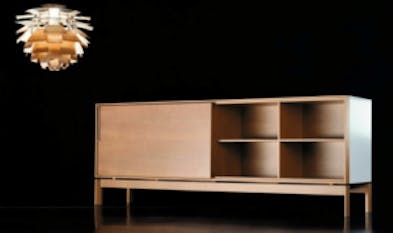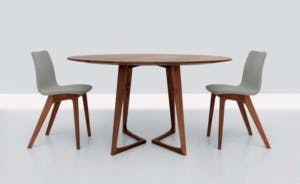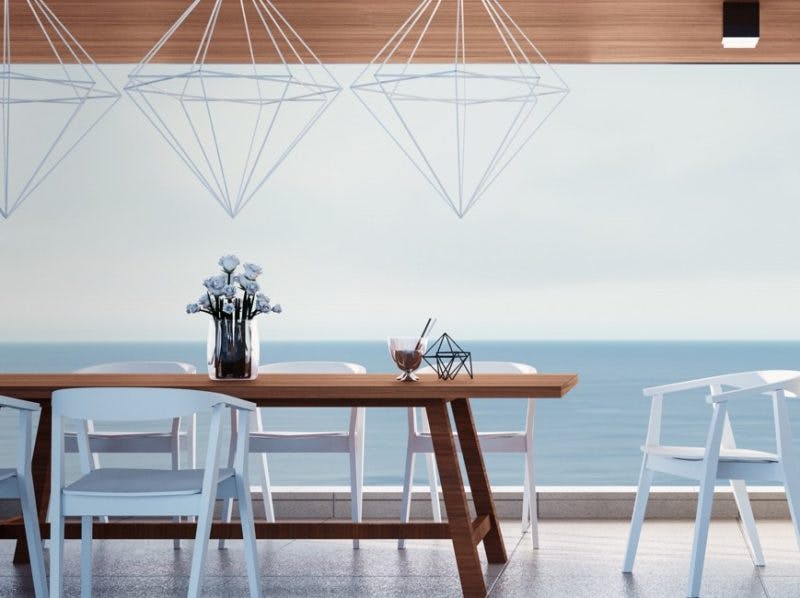Inside Stephen Spencer A Well Furnished Mind
In our ever-evolving city of Vancouver, luxury retailers are a special rarity. Delving further into that idea, luxury furnishings are even more seldom. So when given the chance to speak to the owner of Chinatown’s largest luxury interior retailer, Stephen Spencer of Spencer Interiors, it was as if a hidden treasure had been discovered. Here Stephen gives us sophisticated insight into his world of timeless, modern, furniture. Inside Stephen Spencer a well furnished mind!
Words by Christina Chan
The City: So Stephen why don’t you tell us a little bit about yourself and the story of how it all came about!
Stephen Spencer: Well I always say it was a temporary lapse of judgment, but I had basically worked for quite a number of years in the advertising industry and already had an interest in design and photography. There was a period where I was traveling to Italy, quite extensively, that I came into contact with manufacturers and at the same time, I was building a new house of my own in Vancouver, which became the impetus to look for modern furniture. Meanwhile I felt like there was room in the marketplace and I was ready for a new career path; I was quite successful in the advertising industry but needed a new challenge. What convinced me even further was the fact that all the skill sets I had acquired from a design perspective were transferrable: colour, layout, and all that sort of thing. It was all relevant.
 The City: What makes Spencer Interiors unique to Vancouverites?
The City: What makes Spencer Interiors unique to Vancouverites?
SS: Well the way we’ve done things is quite different. We went around and we sourced European brands that are truly authentic in the sense that they are produced and consumed within Europe, not just produced primarily for export. We decided to do this for a couple reasons. For one, the advantage of a European brand is that there is a price advantage and secondly, smaller companies are generally more sensitive and responsive to the demands of the marketplace. So if they see a demonstrable, real trend from consumers, they will typically respond much quicker. Our brands are not typical export brands; our brands are lesser known and we have to work harder to educate people about who they are and what their story is, but that’s what we like to focus on. What also sets us apart is the fact that we typically carry enough inventory for clients that wish to furnish their entire home right away, without the usual length ordering times. In that respect, we’ve attracted a lot of Asian clientele because that’s typically how many of them like to shop. They don’t shop the same way North Americans shop, so our business model happens to cater to many of their sensibilities and tastes. As Asia is now the largest consumer of luxury goods in the world, having a business model, which is aligned with this market, is of course positive.
The City: With Asia being so influential at the moment was that part of the reason you moved from your old location to Chinatown?
SS: No actually, when we had bought the space 2 years ago, moving here was a risk because the direction of the neighborhood was not yet established. I think The City of Vancouver feels that Chinatown should retain some of its aesthetic cultural heritage but at the same time, they’d like to see it become a mix and become a more vibrant, active part of the city punctuated by completely disparate and different kinds of businesses. And so they thought we were a good fit and I personally felt that if we moved here early enough, we could have enough of an influence in the direction the neighborhood was going to go in that we might provide some positive impetus. So after we received permission from The City of Vancouver to use 4 retail units as 1 large space, we became the largest luxury retailer in Chinatown and the response has been overwhelming ever since we opened our doors.
The City: How do you decide which pieces to purchase for your store?
SS: It’s a combination of things. Basically, we are editors. So if you look at product offerings that are available in Europe, there are literally hundreds of thousands of things that we could choose to bring here and show. So which things end up making it here is a process of elimination. One of the ways we approach it is we look at trends that are palatable for our audience here. As some trends never catch on, we’re mindful of this, and we edit out things that we think are not relevant. The other guiding principles for us are quality, timelessness, and quite honestly, things that we admire. Our mantra is trying to create a look that is a warm, approachable, soft kind of modernism. Over the course of 8 years, one of our most popular lines (the family run Cecchini zebra wood line) (Photo 1) has remained a bestseller from day one, so it goes to show that certain designs never go out of style, and that timelessness, quality, and longevity will always matter.
 The City: Speaking of trends, what are the current ones in interiors right now? Colours? Designs? Textures?
The City: Speaking of trends, what are the current ones in interiors right now? Colours? Designs? Textures?
SS: The best way to answer that question would be to ask you a question, “what part of the world are you talking about?” We are an international store and most people who come to our store in Vancouver don’t know this, but a significant portion of our business is outside of the country. So we find that trends vary depending on which part of the world we are talking about.
The City: Well what trends do you predict?
SS: If I were to look at all the markets that we work in all over the world, the single biggest trend is that amongst our most sophisticated clients they are designing environments that integrate different approaches into a single setting. What I mean by that is they aren’t doing a pure modern, stripped down kind of Bauhaus driven aesthetic, but instead creating a look which is more diverse and incorporates things such as antique Tibetan rugs mixed with traditional solid wood pieces from Southern Italy or they’re mixing occasional antique pieces with blown glass. In Vancouver, the kind of look that most people gravitate to is a more pure sort of showroom style where things tend to match perfectly. I am fond of saying that “the magic is in the mix”. In this respect, we encourage clients to incorporate elements from their own cultural heritage into the mix when making their furniture buying decisions. We think it’s important to not only acknowledge those cultural influences but to incorporate them into one’s living environment in an authentic way. There’s something quite refreshing about doing a home for someone where at the end of the process, the end result is a real reflection, not only of what’s happening in the furniture world from a design perspective, but also a real reflection of what’s happening in that person’s own life, who they are, and where they come from. So that when that person walks into their own home, it feels like a home, and not a showroom. To me, this is the single biggest trend.
The City: For people who are just buying a place, where would you suggest for them to start furnishing first?
SS: Well the 3 things that people typically look at purchasing first are a bed, a dining table, and a sofa. If they already had those essentials and were just looking to embellish, what most people tend to do is focus on the rooms that get the most use. The rooms that typically get the most use right now are, for lack of a better word, your kitchen/living room. The old days of having a separate living room and a separate kitchen are gone. So because spaces are generally much smaller, I would suggest focusing on quality and because they may only have one room where they spend most of their time, furnishing it with pieces that are multifunctional and practical is reasonable. Most people want beautiful things, but they also want them to be practical.
The City: What’s the most common request you hear from your clients? Are they more concerned about design or functionality?
SS: That seems to depend on the income level of the client, we notice that as income goes up, purchasing tends to be driven more by design considerations, rather than practicality. On the extreme end, billionaire clients for example, will tend to be influenced primarily by design and aesthetics.
The City: Well for those who are on a budget but still wish to furnish their homes beautifully, how would you suggest they do this?
SS: The key is to try to approach your furnishing scheme with a plan that is mindful of how you actually live, what your lifestyle is, and to invest in some quality pieces. We suggest buying one or two really nice pieces that you love and that you can see living with for 10 or 20 years. A good example of this would be a dining room table. It isn’t a superfluous piece and everyone needs one, so investing in a solid wood dining table that you can use for many years, can be a good way of starting your furniture acquisitions. As living areas are now smaller, pieces that occupy a large visual footprint in a room should be given special consideration. One of our most popular dining tables in solid wood is the ‘Twist Table’ by Zeitraum (Germany) (Photo 2). People appreciate this piece because it is a piece of quality furniture that will stand the test of time. In contrast, if you look at price point furniture, the quality is usually so bad that it’s basically designed as disposable furniture. In fairness, many of the qualitative differences between well made furniture and low end furniture are not immediately visible, which is why we encourage clients to shop around and ask questions about how goods are made and where they come from. If it were I starting out, I would buy one or two really nice pieces, and then look around for some affordable options especially for things such as accessories, lighting, cushions, and dining chairs. What we try to do is have a range of price points, so that even if you’re a student or someone who simply appreciates design and has a passion for modernism, then there’s something for you to take away that’s relatively affordable.
The City: Have you ever thought about designing your own furniture?
SS: Briefly. With me running a retail store and an international business at the same time, the thought of designing furniture and then going through the process of manufacturing it, I just simply wouldn’t have the time. We do however, provide constructive feedback to manufacturers and sometimes they will take our advice. For instance, based on our suggestion, Cecchini came out with a walnut stained finish (Photo 3) that became a win-win situation for both of us. So we do participate to some extent in the design process, but typically we focus on what we do best, which is bringing in quality furniture, and trying to provide a quality purchasing experience. Our mantra and our goal is very specific, which is to deliver a purchasing experience at the same high level of quality as the merchandise we sell. We want those two things to be hand in hand.
 The City: Wrapping up the end of our interview, what is one last piece of personal advice you’d give to our readers?
The City: Wrapping up the end of our interview, what is one last piece of personal advice you’d give to our readers?
SS: The one thing that I can say is that there’s different ways of purchasing furniture and furnishing your home. And I think it’s important that everyone does it in a way where they end up with something that’s congruent and authentic to whom they are. People shouldn’t be trying to desperately follow trends or be afraid that they’re not going to be in style. What people can consider doing instead, is to survey what’s in the marketplace, see what they like, and then pick a direction. The most common mistake we see people make is starting the process without doing any kind of homework and after purchasing a dominant piece, every single purchasing decision they make after that, is basically compounding that initial mistake. So we like to remind clients that pieces you buy at the beginning of the process are the pieces that will determine the direction you’re going in. But if you don’t know what that direction is, we also encourage clients to wait in some cases. What we mean by that is to simply pick one or 2 pieces, carefully, that you need to live in your new home, but then try living in the space for 2 to 3 months first so you get to know your space, your building, and how you’ll actually live in it. When you do that, you have a much better idea of furnishing the space in a meaningful way where your purchase decisions will actually reflect the way in which you’re going to use the space.
The City: That’s absolutely wonderful how you’re so personal with your clients! Thank you so much for your time.
SS: You’re very welcome!
Be sure to check out Stephen’s store online and in person at:
Spencer Interiors
708 Main Street
Vancouver, BC
www.spencerinteriors.ca


